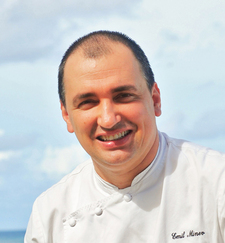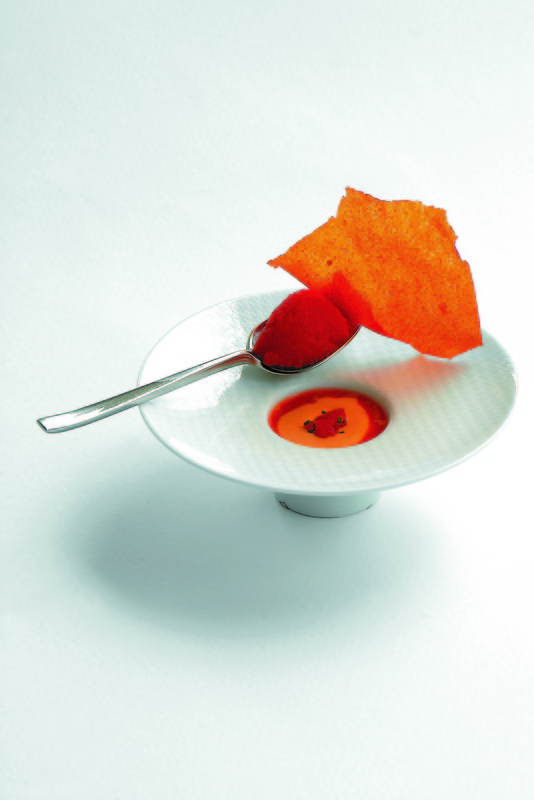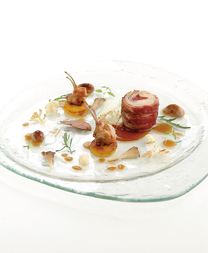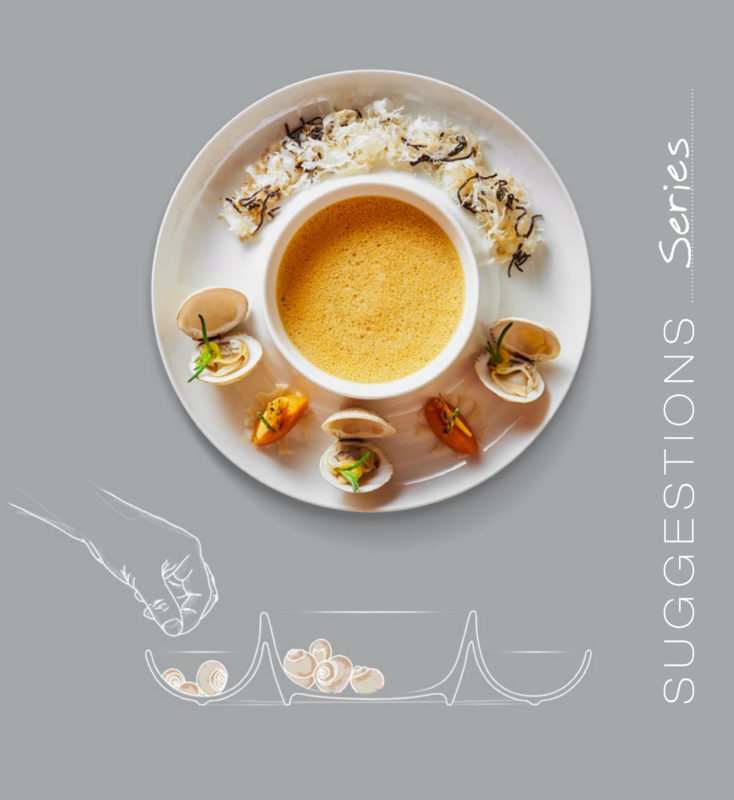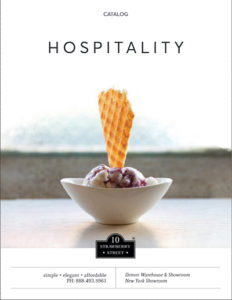Chef Emil Minev Recently, TabletopJournal had the privilege to ask a few of questions of Chef Emil Minev, from the Shangri-La Villingili Resort in The Maldive Islands. Chef Minev uses a variety of tabletop pieces to compliment his culinary creations so we thought we’d see where he gets his inspiration, how it is to work in such a resort location, and his overall thoughts on how important tabletop is to food presentation.
Hong Kong-based Shangri-La Hotels and Resorts is Asia Pacific’s leading luxury hotel group, We are also regarded as one of the world’s finest hotel ownership and management companies.With 72 hotels and resorts throughout Asia Pacific, North America, the Middle East, and Europe, the Shangri-La group has a room inventory of over 30,000. In addition, new hotels are under development in Canada, mainland China, India, Philippines, Qatar, Turkey and United Kingdom.
1. You were born in Bulgaria, trained and worked in London, UAE, and The Maldives, so how would you describe your style of cooking and food presentation? What/who have been your major influencers?
I always find it hard to label my style of cooking, and give it a name. However the food I cook is contemporary, but based on the foundations of classic cuisine. I would not say that I keep it simple, because no food at this level of cooking can be simple. I am very keen to use local ingredients whenever possible and apply them to more cutting edge techniques. In the end when it comes to food, it has to taste good and that is the most important no matter what the style of cooking is.
The food I cook also progresses as I move to different parts of the world. If I live and cook in my home country, I would use a lot of fresh herbs and mushrooms from the nearby mountain, fruits and vegetables from the Farmers Market, freshly made yoghurt etc.
Here in Shangri-La’s Villingili Resort and Spa, Maldives, our focus is on our own grown fruits and vegetables. Together with the local community we are growing over 35 different fruits and vegetables and we keep developing this project. Our dream is one day to be able to produce 100% of the fresh fruits and vegetables that we use on the Resort. Our main fish and seafood supply is from the local fishermen, who deliver to us daily.
When it comes to influence, I would say what really changed my vision and my entire perception of cooking was when I first came across the Spanish Vanguard Chefs and their way of thinking and approach the cooking in general. However inspiration also comes from a product, a person, place or just a simple memory from my childhood.
2. What role in the overall guest experience do feel that tabletop – dinnerware, glassware, and cutlery – plays?
The table top is not only a part of interior design of a restaurant these days, but to me it is an essential part of the food concept. At Shangri-La’s Villingili Resort and Spa, we select our dinnerware only after we indentify the culinary concept of the restaurant. For example, at our signature restaurant Dr Ali’s, we serve authentic Indian, Chinese, Vietnamese and Arabic cuisine prepared by the respective chefs. We purchase custom-made plates, designed for us to match the style of cooking of each individual chef. In our fine dining restaurant Fashala, where we serve contemporary European cuisine based on the locally grown ingredients, we use a very modern, neat and sleek line of chinaware
3. We’re told that you are fond of using glass to serve your culinary creations. What is your thinking on glass versus porcelain – or any other type of – serving pieces?
I like to use not only glass, but pieces of wood, lava stones and slides. It gives diversity to the whole experience. To me it is like an opera or theater, as the spectacle progresses, the actors also change their costumes. We have just recently renovated our fine dining restaurant, Fashala which is located on the beach and has breathtaking views across the beautiful blue Ocean. So, we choose a glassware line which completed the surroundings. When it comes to influence, I would say what really changed my vision and my entire perception of cooking was when I first came across the Spanish Vanguard Chefs and their way of thinking and approach the cooking in general. However inspiration also comes from a product, a person, place or just a simple memory from my childhood.
2. What role in the overall guest experience do feel that tabletop – dinnerware, glassware, and cutlery – plays?
The table top is not only a part of interior design of a restaurant these days, but to me it is an essential part of the food concept. At Shangri-La’s Villingili Resort and Spa, we select our dinnerware only after we indentify the culinary concept of the restaurant. For example, at our signature restaurant Dr Ali’s, we serve authentic Indian, Chinese, Vietnamese and Arabic cuisine prepared by the respective chefs. We purchase custom-made plates, designed for us to match the style of cooking of each individual chef. In our fine dining restaurant Fashala, where we serve contemporary European cuisine based on the locally grown ingredients, we use a very modern, neat and sleek line of chinaware
3. We’re told that you are fond of using glass to serve your culinary creations. What is your thinking on glass versus porcelain – or any other type of – serving pieces?
I like to use not only glass, but pieces of wood, lava stones and slides. It gives diversity to the whole experience. To me it is like an opera or theater, as the spectacle progresses, the actors also change their costumes. We have just recently renovated our fine dining restaurant, Fashala which is located on the beach and has breathtaking views across the beautiful blue Ocean. So, we choose a glassware line which completed the surroundings .
4. You are so creative with the plates…..how do you stay equally creative with your selections of glassware and cutlery?
Well, there are a great number of top high end tableware producers these days and I am constantly on the lookout for items with a new design and we always welcome new ideas. But once again, when the certain dish is finalized, the next step is to decide where we are going to plate it? What kind of shape, color or material we have to use in order to complete the dish? Choosing the right tableware is an important part of the creative process.
5. Where do you see the future of tabletop – dinnerware, glassware, and cutlery – going from here?
When it comes to luxury hotels and fine dining restaurants I personally believe we will see more and more of the artistic element on the table top and a cleaner and neat design of the plates, whether it is glass, fine bone china or ceramic.
Chef Emil Minev bio – Emil Minev was born in raised in Bulgaria and started his culinary career in the kitchen of the New Otani (now Kempinski Zografski). From there, Minev moved on to Sheraton Luxury Hotel Collection in Sofi and developed their Capital Bar and Dinner restaurant as one of the top places in the city. With the next stop London, Minev gained training at Le Cordon Bleu and additional training under the watchful eye of Pierre Koffman, who has served as mentor to a number of the England top culinary figrues such as Marco Pierre White, Gordan Ramsay, and Tom Aikens.
Stints at La Tante Claire, The Ritz-London, El Bulli, and Jumeriah Emirates Tower Hotel in Dubai and time at Alain Ducasse Formacion in Paris have all helped form Chef Minev’s unique style of dish presentation.
You can visit Chef Emil Minev’s website by going here: http://www.emilminev.com/

